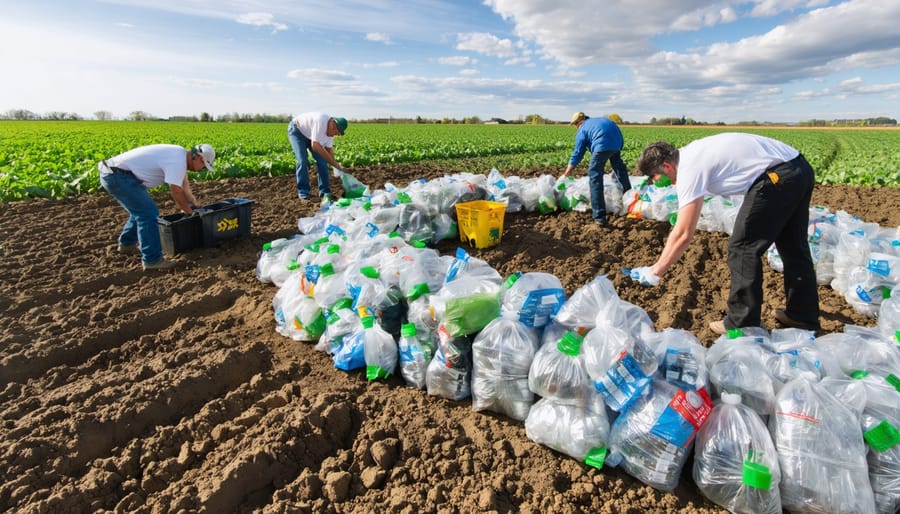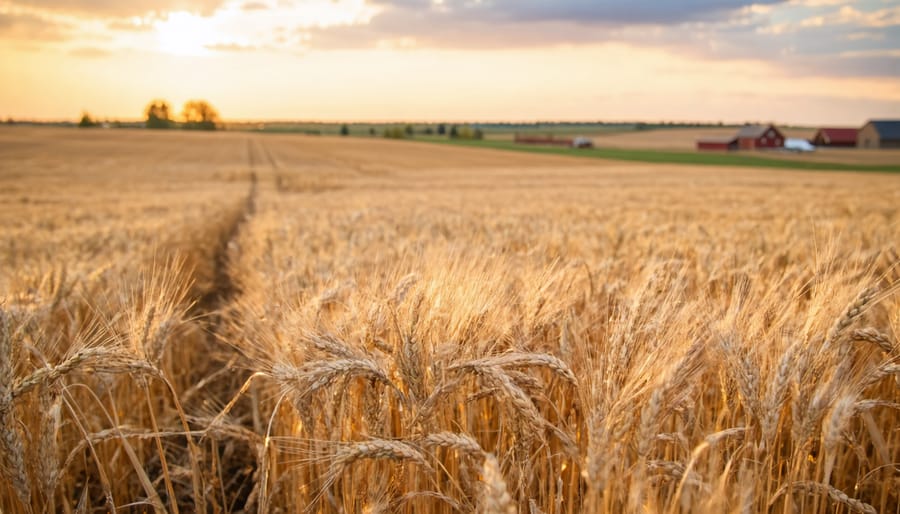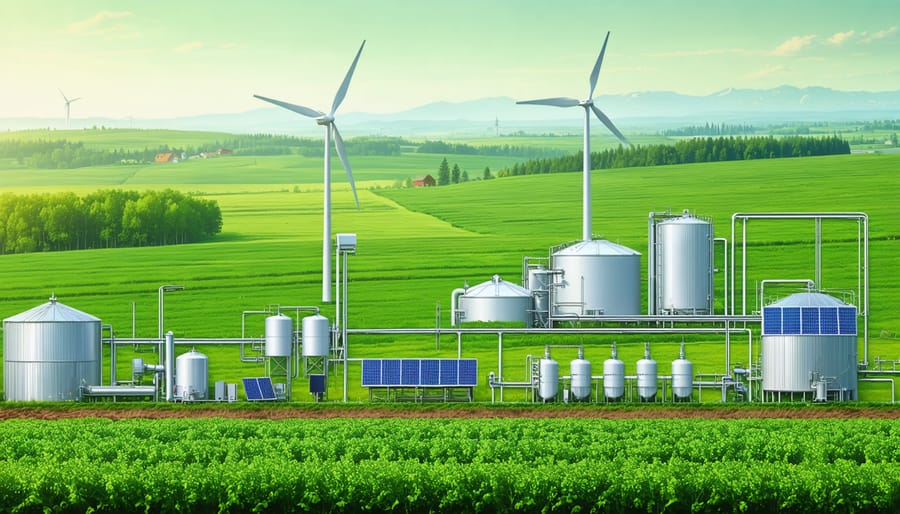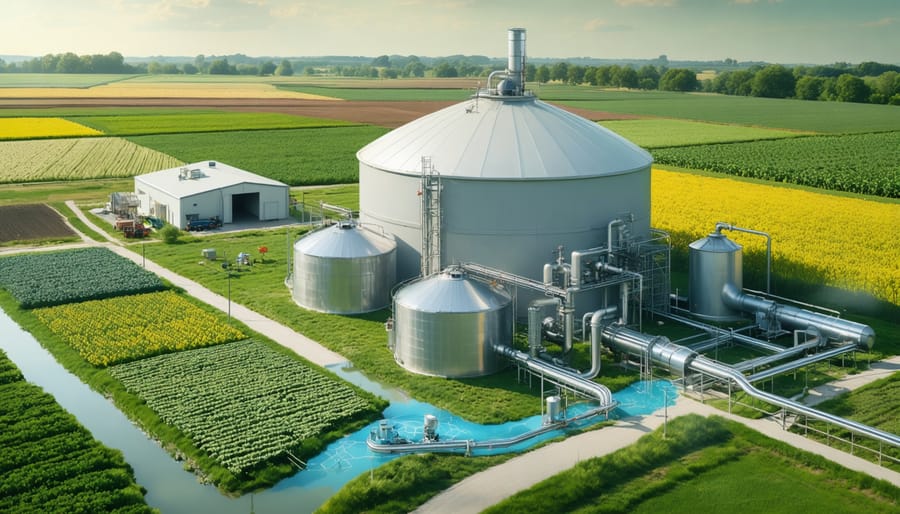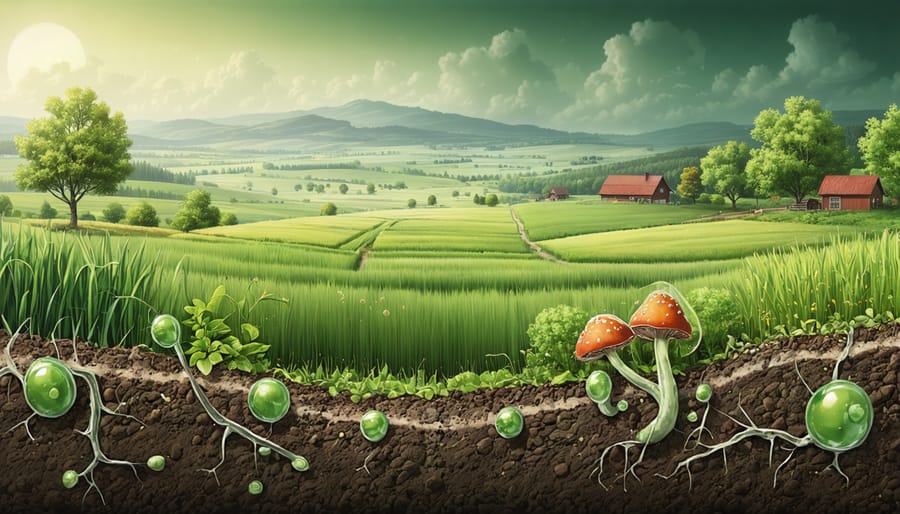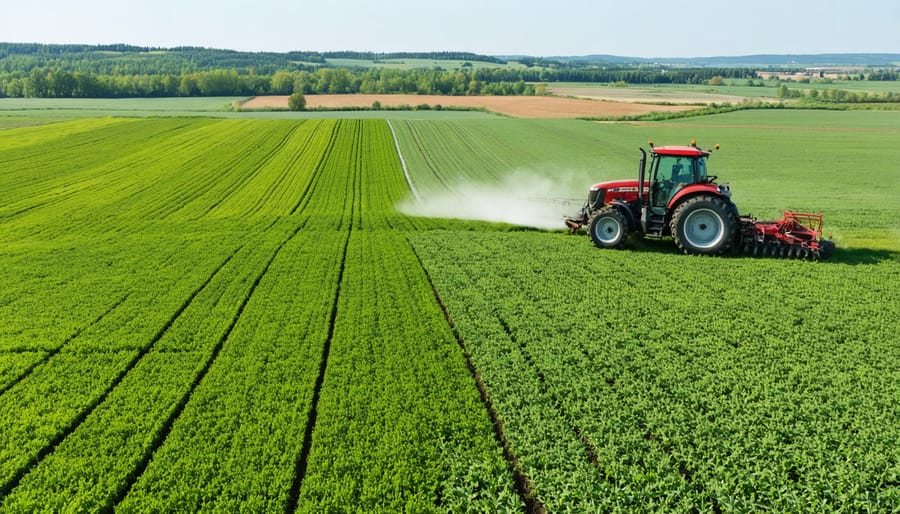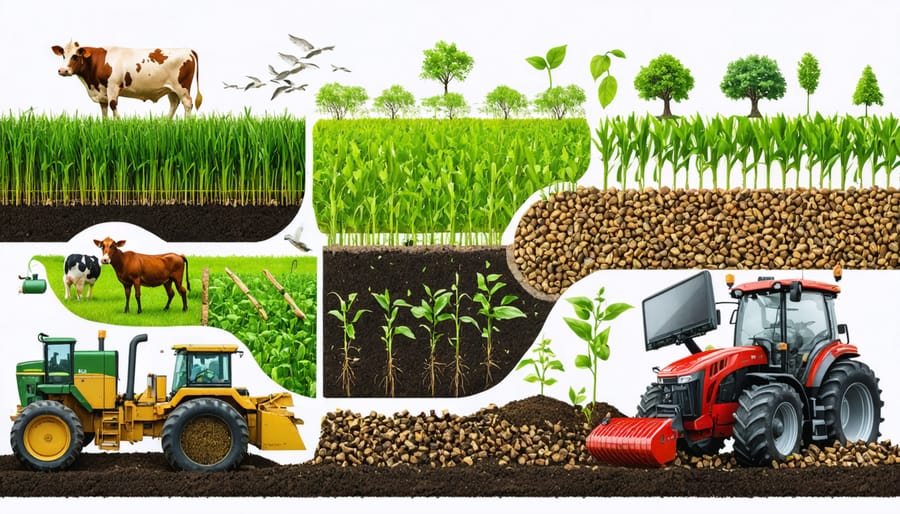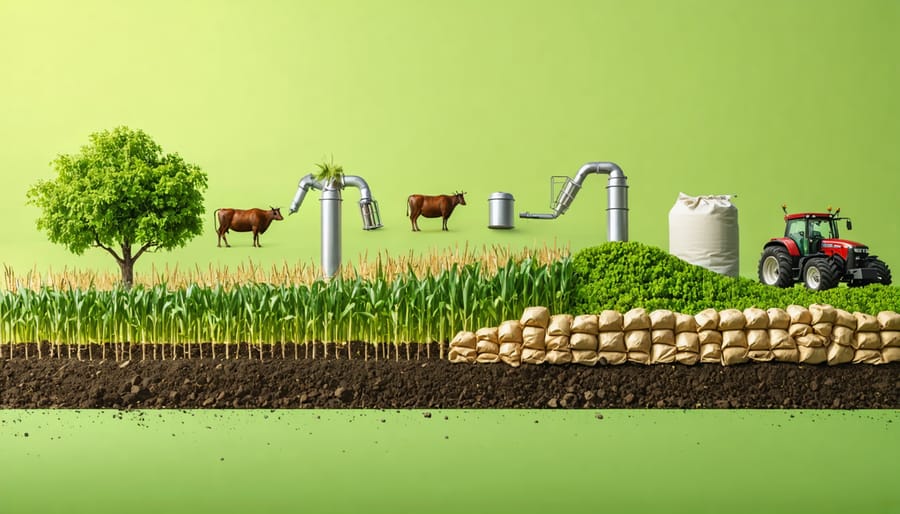Transforming agricultural plastic waste into valuable resources drives modern farming sustainability while protecting our soil and water systems. Canadian farmers implementing circular agricultural practices have reduced plastic waste by 40% through strategic collection and recycling programs. Across Alberta’s 50.5 million acres of farmland, innovative plastic management solutions – from biodegradable mulch films to recycled irrigation systems – are reshaping how we approach agricultural efficiency and environmental stewardship.
The intersection of plastics and agriculture presents both challenges and opportunities. While plastic technologies have revolutionized farming through improved irrigation, reduced water loss, and enhanced crop protection, their environmental impact demands immediate attention. Canadian farmers are pioneering solutions that balance productivity with sustainability, developing systems that maximize plastic’s benefits while minimizing its environmental footprint.
As our agricultural sector evolves, the strategic management of agricultural plastics becomes increasingly crucial for maintaining soil health, reducing waste, and ensuring long-term farm viability. Through collaboration between farmers, researchers, and industry partners, practical solutions are emerging that protect both our agricultural productivity and environmental legacy.
Common Agricultural Plastics: Understanding What’s on Your Farm
Essential Plastic Products in Modern Farming
Modern farming relies heavily on several key plastic products that enhance productivity and efficiency. Mulch films, available in both black and clear varieties, help control weed growth, maintain soil temperature, and conserve moisture – particularly valuable during Alberta’s variable growing seasons. These films are commonly used in vegetable production and can extend our relatively short growing season by up to three weeks.
Greenhouse covers, typically made from polyethylene or polycarbonate, enable year-round production even during our harsh winters. These durable materials provide excellent light transmission while maintaining crucial heat retention, making them essential for operations ranging from small market gardens to large commercial greenhouses.
Silage bags and bale wraps have revolutionized feed storage for livestock operations. These white plastic wraps create an airtight seal that preserves feed quality and prevents spoilage, ensuring valuable fodder remains fresh throughout our long winter months. Irrigation systems also depend on plastic components, from drip tape to PVC pipes, helping farmers manage water resources efficiently.
High tunnels and row covers, made from lightweight plastics, offer crop protection from early and late frosts, extending the productive season for market gardeners across the province.
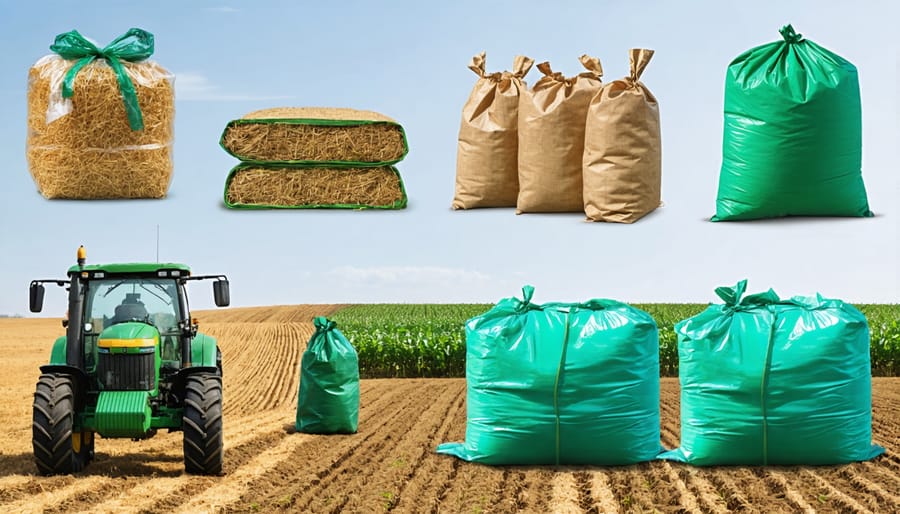
Benefits and Environmental Impacts
Agricultural plastics have revolutionized farming practices across Canada, offering significant advantages in crop production and resource management. Plastic mulch films help retain soil moisture, reduce weed growth, and maintain optimal soil temperatures, leading to earlier harvests and increased yields. Greenhouse plastics extend growing seasons in Alberta’s challenging climate, while silage bags and bale wraps preserve feed quality and reduce storage losses by up to 30%.
However, these benefits come with environmental considerations that farmers must carefully weigh. Plastic fragments can accumulate in soil, potentially affecting long-term soil health and microorganism activity. When improperly disposed of, agricultural plastics may contaminate waterways and harm wildlife. The challenge of proper disposal is particularly relevant in rural Alberta, where recycling facilities might be distant.
The key is finding the balance between utilizing plastics’ benefits while minimizing environmental impact. Many Alberta farmers are adopting innovative practices, such as using longer-lasting plastic products, implementing proper disposal methods, and exploring biodegradable alternatives. These approaches help maintain productivity while demonstrating environmental stewardship, a value deeply rooted in Canadian farming communities.
Alberta’s Innovative Plastic Waste Solutions
Local Collection Programs That Work
Alberta farmers are leading the way with innovative zero waste initiatives that demonstrate the power of community-driven recycling programs. The Cleanfarms Agricultural Plastics Recycling Program, operating in several counties including Mountain View and Red Deer, has successfully collected over 100,000 kilograms of grain bags and twine since 2019.
In Southern Alberta, the Coaldale Collection Site has become a model for efficient plastic recycling, offering convenient drop-off times and assistance with material preparation. Farmers can bring in their used grain bags, twine, and greenhouse films during regular business hours, with staff available to help sort and process materials.
The Wheatland County pilot project showcases another successful approach, implementing a mobile collection service that visits farms directly. This program has achieved an impressive 80% participation rate among local producers, demonstrating that accessibility is key to program success.
Northern Sunrise County’s partnership with local agricultural retailers has created convenient collection points where farmers can drop off materials while picking up supplies. This integration with existing farm routines has significantly increased participation rates and reduced transportation barriers for busy producers.
These programs show that when communities work together and make recycling convenient, farmers readily participate in responsible plastic disposal practices.
On-Farm Storage Best Practices
Proper storage of agricultural plastics is crucial for maintaining their condition until recycling or disposal. Start by thoroughly cleaning and drying all plastic materials to remove soil, plant matter, and moisture. This step prevents contamination and reduces pest attraction during storage.
Create a designated storage area on your farm that’s easily accessible but away from daily operations. Choose a location sheltered from strong winds and direct sunlight to prevent plastics from becoming brittle or blowing away. Consider using old grain bins or covered storage areas to protect materials from the elements.
Bundle similar materials together using strong twine or wire – keep grain bags separate from twine, and silage wrap separate from containers. Roll items tightly and secure them well to minimize storage space and prevent unraveling. For smaller items like containers and jugs, stack them efficiently after ensuring they’re clean and dry.
Label your storage areas clearly and maintain an inventory of materials. This organization helps track what you have and when it needs to be transported for recycling. During winter months, try to keep plastics elevated off the ground to prevent freezing to the surface and damage during removal.
Remember to check your local agricultural plastic recycling program’s requirements – some may have specific preparation guidelines that affect how you should store materials. Regular monitoring of your storage area helps identify any issues early and maintains good farm aesthetics.
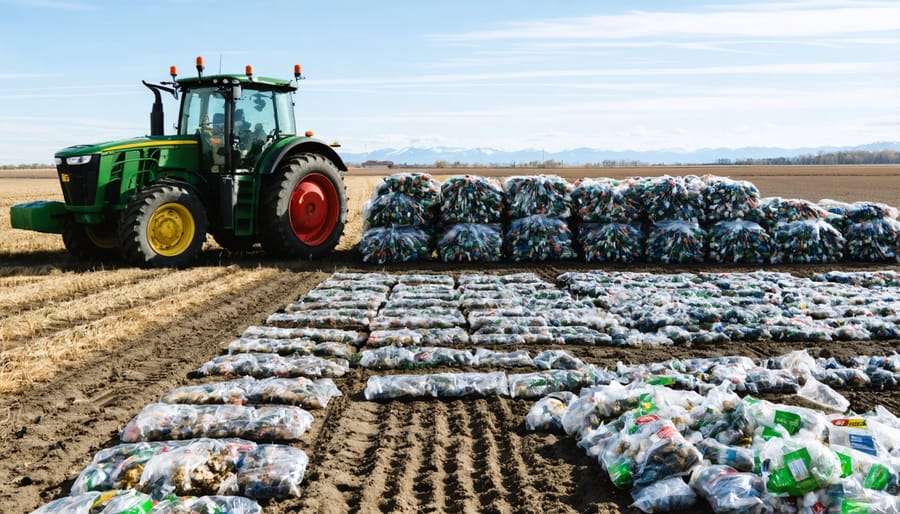
Cost-Effective Disposal Methods
Managing agricultural plastic waste doesn’t have to break the bank. Many Alberta farmers have found success with a combination of disposal methods that balance cost and environmental responsibility. The most cost-effective approach often starts with proper sorting and cleaning of materials, which can significantly reduce disposal fees.
Local recycling programs, when available, typically offer the most economical solution. Many municipalities provide seasonal collection events where farmers can dispose of their agricultural plastics at reduced rates or sometimes free of charge. For example, several counties in central Alberta have implemented successful collection programs that cost farmers as little as $5 per tonne of clean plastic waste.
Participating in community collection programs can also help reduce transportation costs. By coordinating with neighbouring farms, you can share delivery expenses to recycling facilities. Some recycling companies even offer pick-up services when minimum volume requirements are met, usually around 2 tonnes of material.
For materials that can’t be recycled, landfill disposal remains an option, though costs vary significantly by region. Current rates in Alberta range from $50 to $120 per tonne. To minimize these expenses, consider compacting materials when possible, as many facilities charge by volume rather than weight.
On-farm storage solutions, such as dedicated collection areas with proper covering, can help you accumulate larger quantities before transport, making each trip more cost-efficient. Remember that proper storage also preserves material quality for recycling, potentially leading to better acceptance rates and lower processing fees.
Sustainable Alternatives and Future Solutions
Biodegradable Options for Alberta’s Climate
Alberta’s unique climate presents both challenges and opportunities when it comes to biodegradable alternatives for agricultural plastics. With temperatures ranging from extreme cold to hot summers, and varying precipitation levels across regions, farmers need solutions that can withstand these diverse conditions while maintaining their structural integrity.
Several biodegradable options have shown promising results in local field trials. Corn-based poly-lactic acid (PLA) mulch films have performed well in southern Alberta’s irrigated crops, particularly in vegetable production. These materials break down into harmless compounds within one to two growing seasons, depending on soil conditions and microbial activity.
For silage and hay storage, companies are now offering biodegradable wrap alternatives made from plant-based polymers. These materials have been tested to withstand Alberta’s winter conditions while maintaining proper fermentation. Though currently more expensive than traditional plastic options, many farmers report the environmental benefits and reduced disposal costs make them worthwhile investments.
Paper-based alternatives, reinforced with natural fibers, have shown success in shorter-term applications like temporary row covers and early-season frost protection. These products work particularly well in areas with moderate rainfall and can be directly incorporated into the soil after use.
Local agricultural research stations have been conducting trials with biodegradable twine made from natural fibers such as hemp and jute. While these alternatives may not last as long as synthetic options, they’ve proven effective for single-season use and eliminate the need for plastic twine removal and disposal.
When selecting biodegradable alternatives, farmers should consider their specific growing conditions, crop type, and intended duration of use. Consulting with local agricultural extension offices can help determine the most suitable options for individual operations.
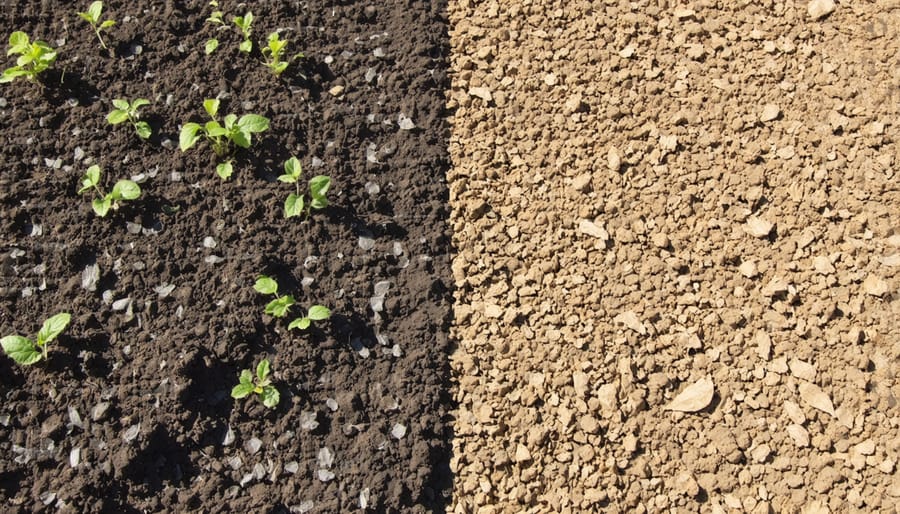
New Technologies in Farm Plastics
Exciting developments in agricultural plastics are revolutionizing how Canadian farmers manage and reduce their plastic waste. Recent innovations in biodegradable materials have introduced mulch films that break down naturally into organic matter, eliminating the need for removal and disposal. These new materials, tested successfully on several Alberta farms, maintain the same protective properties as traditional plastics while significantly reducing environmental impact.
Innovative smart waste management technologies are making plastic recycling more efficient and accessible for farmers. Mobile granulating units, which can process agricultural plastics on-site, are now available through several equipment-sharing programs across Alberta. These units transform used plastics into recyclable pellets, reducing transportation costs and increasing recycling participation.
Canadian researchers have also developed new types of photodegradable plastics specifically designed for our climate. These materials maintain their strength during the growing season but break down more quickly when exposed to sunlight after use. Local trials show these materials perform particularly well in Alberta’s sunny conditions.
Another promising advancement is the emergence of plant-based plastics made from agricultural residues. Several Alberta producers are already testing these materials, which are created using canola and wheat straw. These alternatives not only reduce dependency on petroleum-based products but also create additional revenue streams for crop residues.
Remember to connect with your local agricultural extension office to learn about pilot programs testing these new technologies. Many regions offer cost-sharing initiatives to help farmers transition to these innovative solutions, making sustainable practices more accessible for operations of all sizes.
Taking Action: Your Farm’s Plastic Management Plan
Assessment and Planning Tools
To effectively manage agricultural plastics on your farm, several practical assessment and planning tools are available through Alberta’s agricultural services. The Agricultural Plastics Recycling Group (APRG) offers a comprehensive Farm Waste Assessment Checklist that helps you track plastic usage and identify reduction opportunities.
Start by downloading the Alberta Farm Sustainability Planning Template, which includes dedicated sections for plastic waste management. This template guides you through setting measurable goals, establishing timeline benchmarks, and creating an implementation strategy tailored to your operation.
The Environmental Farm Plan (EFP) workbook contains specific modules for waste management planning, including a plastic audit worksheet. This helps you document current practices and plan improvements while potentially qualifying for environmental stewardship programs.
For day-to-day tracking, consider using digital tools like the Canadian Agricultural Plastic Calculator, which estimates your farm’s plastic footprint and suggests alternatives. Many producers find success with simple spreadsheet templates that monitor plastic purchase, usage, and disposal patterns throughout the growing season.
Local agricultural fieldmen can provide additional resources and personalized guidance in developing your management plan, ensuring it aligns with regional recycling programs and best practices.
Connecting with Local Resources
Alberta farmers have access to numerous resources and support networks for managing agricultural plastics. The Alberta Plastics Recycling Association (APRA) operates collection sites throughout the province, making it convenient for farmers to dispose of their agricultural plastics responsibly. Cleanfarms, a national non-profit organization, partners with local municipalities to provide recycling programs specifically designed for grain bags, twine, and other farm plastics.
Many Agricultural Service Boards (ASBs) offer guidance and assistance with plastic waste management. These local boards can connect farmers with recycling facilities and provide information about best practices for handling different types of agricultural plastics. The Agricultural Research and Extension Council of Alberta (ARECA) regularly hosts workshops and educational sessions on sustainable farming practices, including plastic waste reduction strategies.
For farmers seeking financial support, the Canadian Agricultural Partnership (CAP) provides grants and funding opportunities for environmental stewardship initiatives, including improvements in waste management systems. Local agricultural societies and farmers’ associations often maintain networks where members can share experiences and solutions for managing plastic waste effectively.
To stay informed about available programs and resources, farmers can contact their regional Agricultural Fieldman or visit their county office.
As Alberta’s farming community continues to evolve, managing agricultural plastics sustainably is both a responsibility and an opportunity. By implementing proper recycling programs, exploring biodegradable alternatives, and maintaining strong collection practices, we can significantly reduce plastic waste while maintaining productive farms. Remember that every action counts – whether it’s properly storing silage bags, participating in local recycling initiatives, or trying new eco-friendly products. Together, we’re building a more sustainable agricultural future for Alberta, protecting our soil, water, and air for generations to come. Let’s continue sharing successful practices, supporting local recycling programs, and staying informed about emerging solutions. Your commitment to responsible plastic management today helps ensure a thriving agricultural sector tomorrow.

